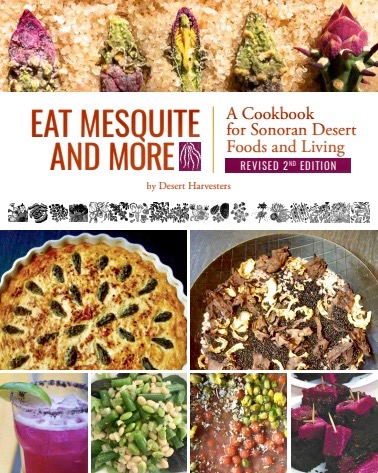
Hello friends, Amy here enjoying another great year for the wolfberry bush (Lycium fremontii …I think) in my yard. Tucson’s native species of the Chinese goji berry, they are similarly packed with antioxidants and health benefits. In the tomato family, it’s called tomatillo in Spanish, not to be confused in size, shape, color or taste to the garden variety of husked ground cherries that go by that name. Wolfberries taste somewhat like tomatoes and work well in sweet and savory dishes, when I manage to harvest more than I eat raw from the bush. Thriving on only rainwater, one huge plant produces plenty of fruit for me and the resident phainopeplas.

Inspired by this recipe for millet balls, I used fresh wolfberries in place of dried Turkish barberries.

It was delicious! It reminded me of falafel, crispy on the outside and grainy on the inside. A simple cilantro, garlic, lemon juice, olive oil chutney complimented them perfectly.

So the next time, I decided to use amaranth seeds. I bought this from the store, but you can harvest your own from wild or cultivated plants in the late summer if you’re ambitious.

I toasted them in oil until they became a shade darker and a few of them popped open.

I added water, three times the volume of amaranth seed, and cooked in the solar oven until it was creamy. Then I mixed in fresh wolfberries and enough flour to make a soft dough.

The dough was muuuuch stickier, so I added significantly more flour than for the millet balls and still they looked shaggy. (I used all purpose wheat flour but next time will try amaranth flour).

The toasted flavor came though and I’m glad the only seasoning I used was salt and wolfberries. The dough certainly didn’t need any egg or flax egg to hold together! They baked up just as well as the millet version, but with the texture of a cookie. Next I’ll try them sweetened!

I served them with a lemon pickle but that tomatillo salsa would be good. I took the rest to a picnic among the wildflowers. Happy spring!










































 Each squash plant produces flowers that make pollen (male flowers) and flowers that make fruit (female flowers). Each flower only opens for one day. On that day insects (or a human with a tiny paint brush) pollinate from one flower to the next, from the same or different plants, resulting in the famous swelling summer squash. Without pollination, the little fruit withers and dries. Looking at the stem below the flower is the fastest way to determine a fruit or pollen producing flower.
Each squash plant produces flowers that make pollen (male flowers) and flowers that make fruit (female flowers). Each flower only opens for one day. On that day insects (or a human with a tiny paint brush) pollinate from one flower to the next, from the same or different plants, resulting in the famous swelling summer squash. Without pollination, the little fruit withers and dries. Looking at the stem below the flower is the fastest way to determine a fruit or pollen producing flower. 




























